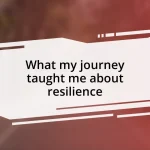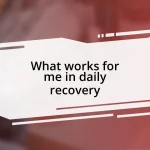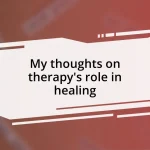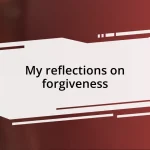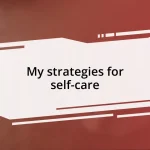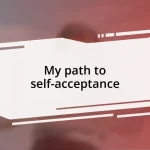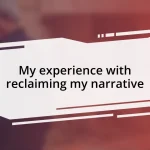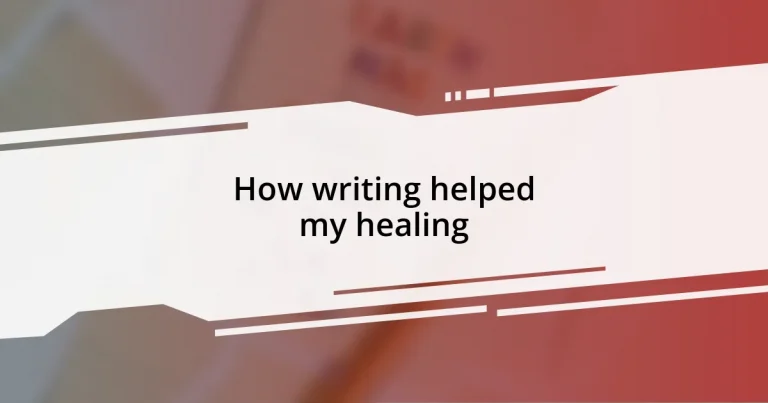Key takeaways:
- Writing serves as a safe space for expressing and processing overwhelming emotions, leading to personal insights and healing.
- Therapeutic writing techniques like free writing and gratitude lists help articulate feelings, shift focus, and foster self-reflection.
- Creative writing and storytelling transform personal experiences and emotions into structured narratives, facilitating understanding and resilience.
- Journaling provides a means to confront fears and grief, creating clarity and a bridge towards acceptance and emotional release.

Benefits of writing for healing
Writing has an incredible ability to create a safe space for expressing thoughts and emotions. I’ve found that when I put pen to paper, I can explore feelings that are often too overwhelming to voice. Have you ever felt like you were carrying a heavy burden? Writing allows me to lighten that load, confronting my struggles instead of burying them.
There’s also something deeply cathartic about revisiting memories through writing. Once, I wrote about a challenging period in my life, and as the words poured out, I experienced a wave of emotions that took me by surprise. This process helped me not just to relive the pain, but to understand it—transforming my grief into a deeper sense of self-awareness. How many times have you thought you were past a hurt, only to have it resurface? Writing can be a tool to help navigate through that tangled web of emotions.
Additionally, I’ve seen the healing power of writing manifest itself in my mental clarity. When I write, I can untangle my thoughts, leading to insights that often remain buried in the chaos of my mind. Do you ever feel overwhelmed with your emotions? Journaling can serve as a mirror, reflecting your innermost thoughts and allowing you to make sense of them. It’s like having a conversation with a trusted friend who always listens.
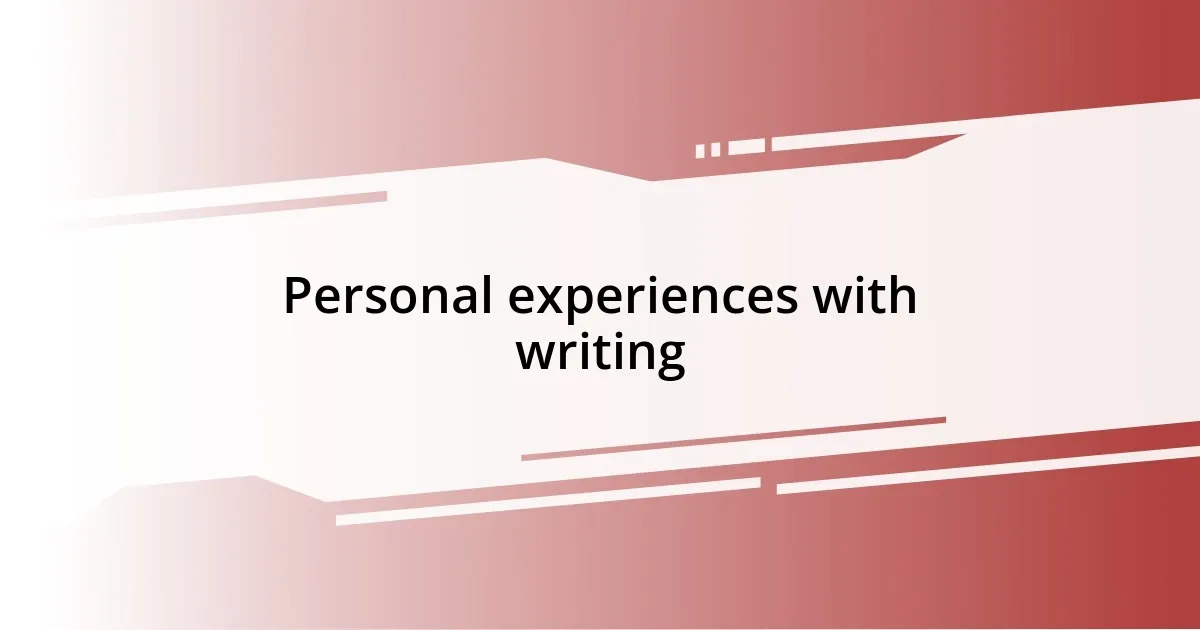
Personal experiences with writing
Writing has become my sanctuary during tough times. I remember a rainy afternoon when I sat down with a blank journal, feeling lost. With each word I scribbled, it was as if I was peeling back layers of my pain. The sentences flowed freely, and for the first time, I felt a sense of relief wash over me, like the clouds parting to let the sun in.
One of my most profound experiences with writing was when I decided to pen a letter to my younger self. I had always carried guilt from my childhood, but in that moment, I could finally express everything I’d wished I had understood back then. This cathartic act transformed my guilt into forgiveness. Isn’t it fascinating how giving a voice to our past can change our present?
I’ve also discovered how writing can act as a formative mirror for self-reflection. I’ll never forget the day I wrote about an argument with a close friend. As I detailed the emotions at play, I realized my own role in the conflict. This clarity not only resolved the situation but deepened our friendship. Have you ever found that putting your feelings into words allows you to see things differently? I sure have.
| Experience | Emotional Insight |
|---|---|
| Writing during tough times | Sense of relief, like sun breaking through clouds |
| Letter to my younger self | Transformed guilt into forgiveness |
| Reflecting on a conflict | Gained clarity and deepened friendship |
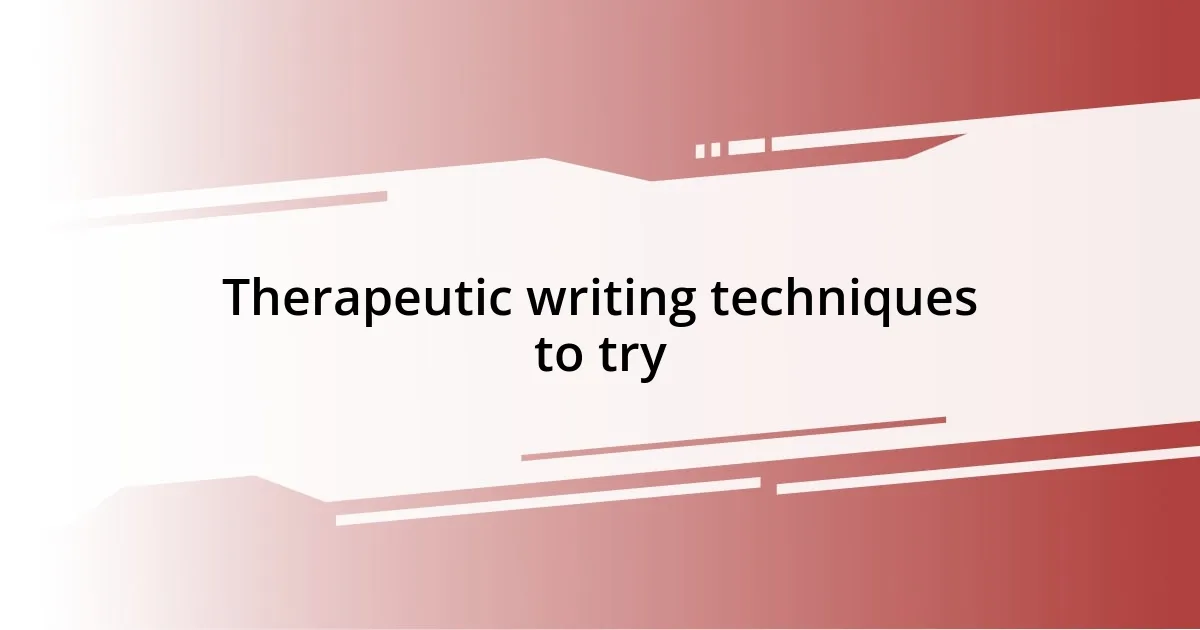
Therapeutic writing techniques to try
Exploring various therapeutic writing techniques can be an enriching journey in healing. I’ve found that free writing, where I allow thoughts to flow without restriction, often reveals surprising insights. It’s like opening a door to my subconscious, where emotions and ideas live, waiting to be uncovered. Each time I engage in this practice, I feel a weight lift as I articulate feelings I didn’t initially know I was holding onto.
Here are some effective therapeutic writing techniques to try:
– Free Writing: Set a timer for 10-15 minutes and write continuously without worrying about grammar or structure. Just let the thoughts spill onto the page.
– Prompt Journaling: Use specific prompts to guide your writing. Questions like “What makes me feel safe?” can evoke deeply personal reflections.
– Letters of Forgiveness: Write letters to yourself or others expressing feelings of forgiveness. You don’t have to send them, but the act itself can be liberating.
– Gratitude Lists: Regularly write down things you’re grateful for. This practice can shift your focus from pain to appreciation.
– Poetry and Creative Writing: Trying your hand at poetry can offer a new lens to express emotions artistically. It’s about playing with words and feelings in a beautiful way.
Among these techniques, I’ve discovered that writing letters—whether it’s to my future self or someone I admire—has been profoundly transformative. It fosters a connection with my emotions, allowing me to articulate hopes and regrets that often swim just beneath the surface. In a recent letter to my future self, I ended up marrying my current fears with aspirations, giving both a voice and a sense of direction. The act of putting pen to paper not only clarified my feelings but laid a roadmap for the future I long to create.
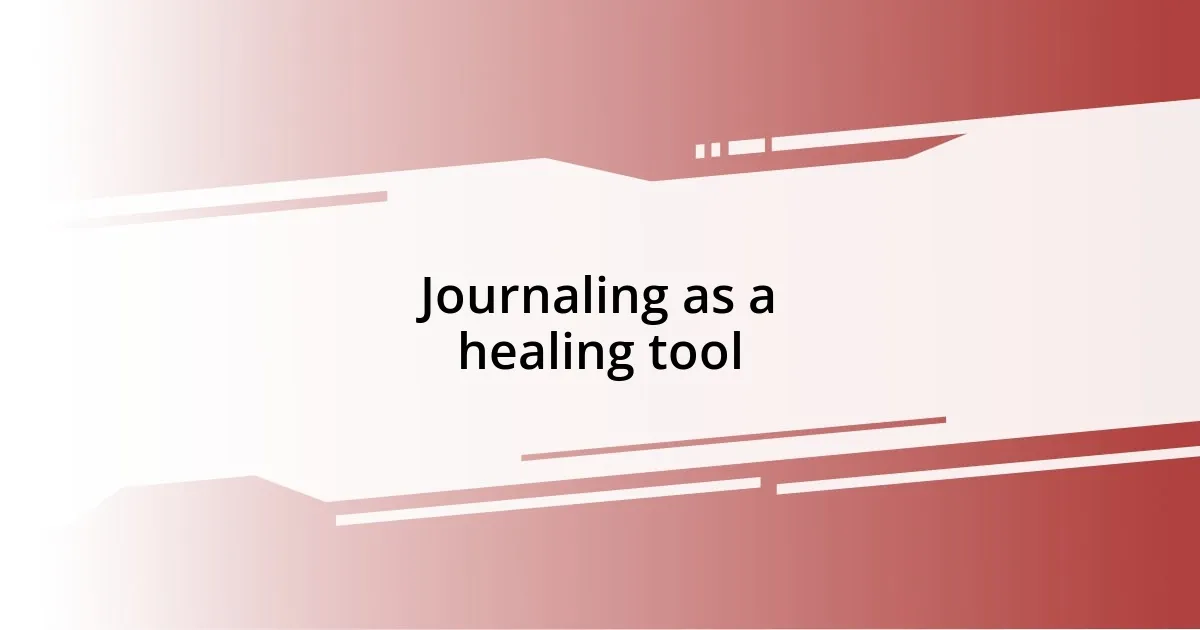
Journaling as a healing tool
I often find journaling to be incredibly therapeutic, almost like having a heart-to-heart conversation with myself. There have been nights when I felt overwhelmed by my thoughts, and as I sat at my desk, the simple act of writing those swirling worries down brought an immediate sense of calm. It’s as if by putting pen to paper, I’m sorting through the chaos in my mind, creating clarity from confusion. Does that resonate with you?
One technique I cherish is the practice of writing letters to my fears. The first time I tried it, I wrote a letter directly addressing my anxiety about uncertainty in my career. By giving my fear a voice, I felt empowered instead of paralyzed. It shifted something within me, allowing me to confront, rather than avoid, the discomfort. Have you ever thought about how articulating your fears can demystify them, making them feel less daunting?
There are moments when I’m overwhelmed by grief, and journaling provides a safe space to express that raw emotion. On one occasion, after losing a beloved pet, my heart felt heavy. Writing about the fond memories and my sadness not only allowed me to honor that relationship but also helped me process the loss. I find it fascinating how tapping into our emotional landscape through writing can create a bridge between pain and acceptance. Have you ever turned to your journal during a tough emotional time and felt the weight begin to lift? It’s such a powerful tool for healing.
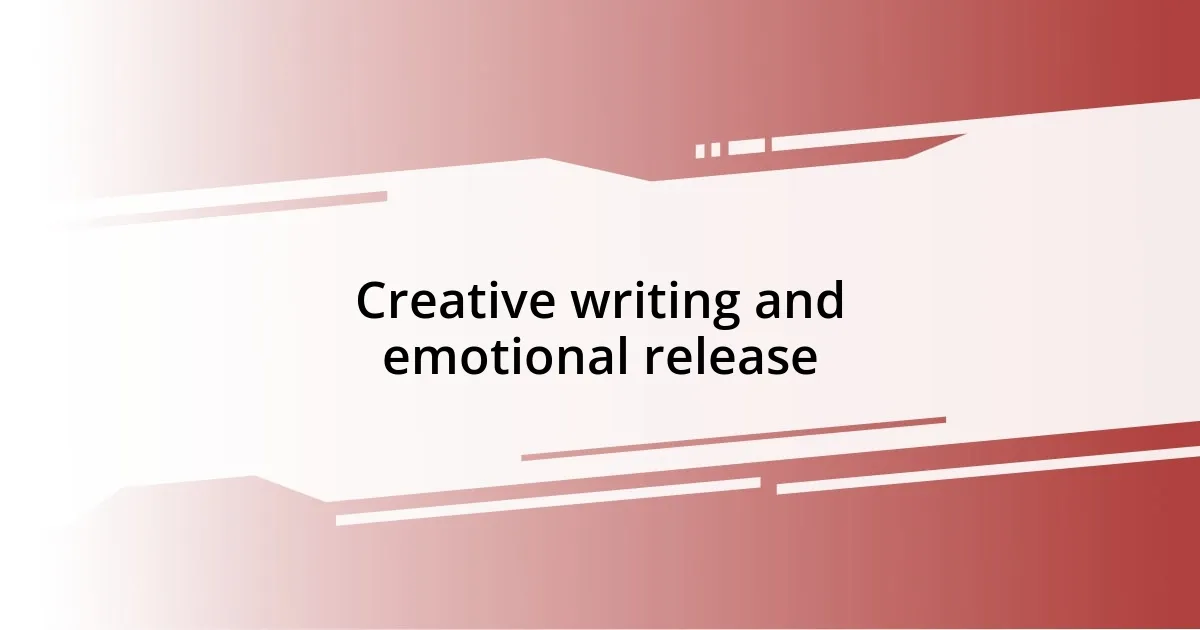
Creative writing and emotional release
I’ve often found that the simple act of creative writing can transform energy that might otherwise feel chaotic into something structured and meaningful. For instance, during a particularly hard week, I turned to writing poetry. Each line became a way for me to channel my swirling thoughts and feelings, like sculpting emotions out of clay. Have you ever written a poem in a moment of distress and felt as if the words themselves provided comfort?
Creative writing acts as a powerful emotional release because it allows me to explore feelings in a safe space. I remember once during a moment of deep sadness, I crafted a short story about loss. As the characters navigated their grief, I couldn’t help but mirror my pain in their journey. This process didn’t just allow me to confront my emotions; it helped me understand them better. Don’t you think using fictional scenarios can shed light on our real-life struggles?
There’s something truly magical about weaving personal experiences into narratives. Last year, I wrote a story based on a transformative moment from my childhood where I first faced rejection. Revisiting that memory and allowing myself to express it creatively felt cathartic. By integrating my past into a compelling tale, I processed the hurt while finding strength in vulnerability. Have you ever shared a piece of your story through writing and felt the healing it brings? It’s an intimate journey toward self-acceptance.
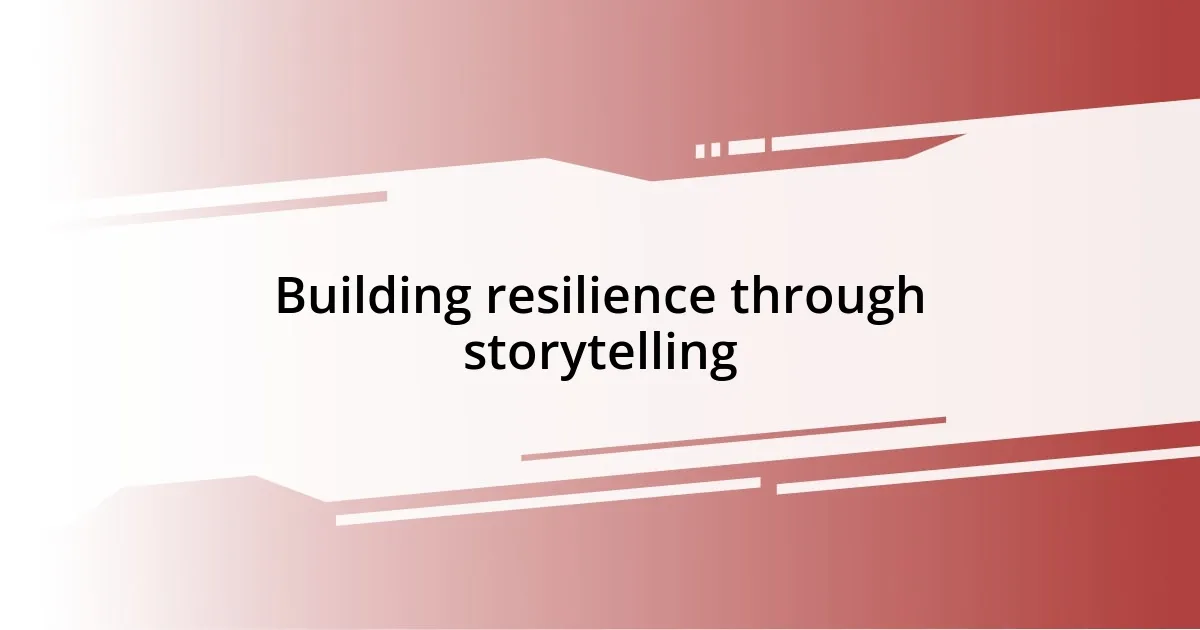
Building resilience through storytelling
Building resilience through storytelling can be a profound way to reclaim our narratives. I remember a time when I felt completely lost after a major life setback. Writing a story that featured a character overcoming challenges not only allowed me to project my feelings into a fictional scenario but also helped me to envision my own resilience. Can you think of a time when telling a story about struggle made you feel stronger?
As I crafted these narratives, I noticed a shift in my perspective. Storytelling provided a unique lens through which to view my challenges; suddenly, my struggles were part of a larger arc of growth and transformation. This experience made me realize that by sharing my story, I could inspire both myself and others. Have you ever thought of how your personal experiences could resonate with someone else facing similar battles?
Moreover, the process of storytelling often encourages me to dig deeper into the emotions behind my experiences. I recall creating a piece that explored the theme of forgiveness after a difficult breakup. The act of writing compelled me to reflect on my feelings of anger and sadness, ultimately leading to understanding and acceptance. Isn’t it fascinating how storytelling can pave the way for healing and resilience, turning our pain into wisdom?
